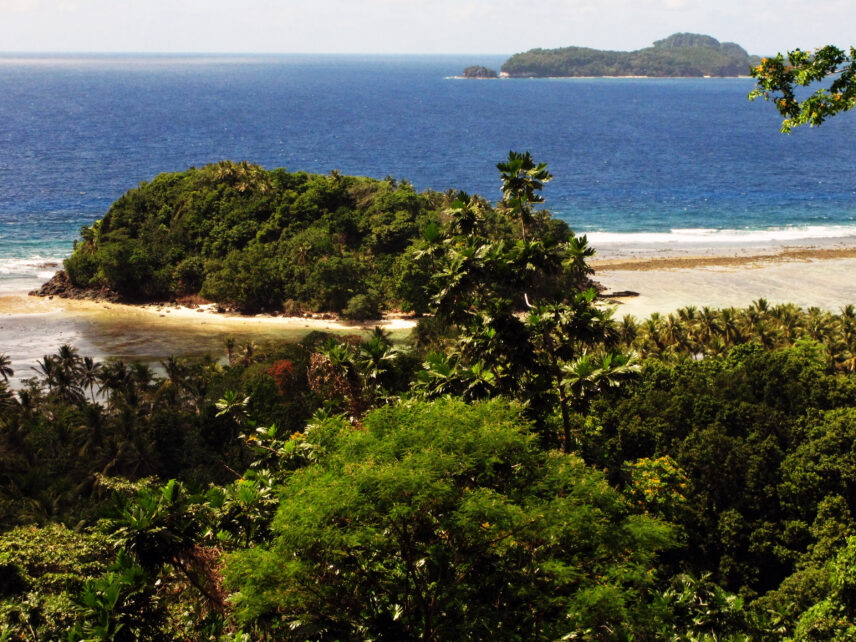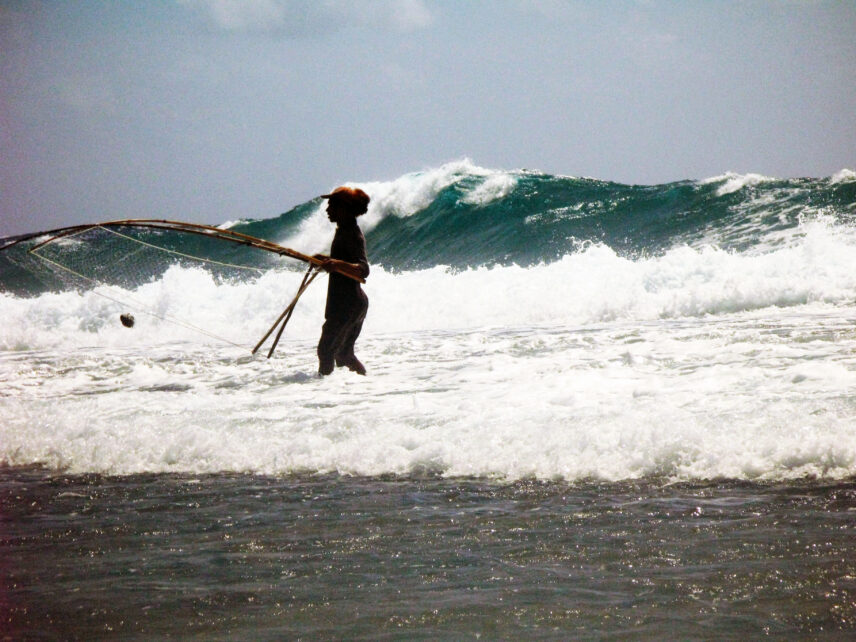Article begins
Note: In 2007–2008, the author was the principal investigator for an NSF-funded study of Taumako voyaging. This incident occurred toward the end of 2008.
Waves were breaking over the gunwales of our dugout canoes. We were tired and preparing to call it a night. Luck had not been on our side.
I’d spent seven months on Taumako, a Polynesian outcropping in the southeastern Solomon Islands. One morning, my friend and local catechist Basil Mekau announced a turtle hunt in preparation for the forthcoming Festival of the Holy Cross. He had gone out the previous night but returned empty-handed. When Basil mentioned plans to try again, I asked if I could join the expedition.
He hesitated, saying they’d be out late, and I’d be uncomfortably cold. When I assured him that I’d deal with the discomfort just like everybody else, he instructed me to grab my paddle. We’d meet at Hapapa, home of a second expedition leader, Allen Ioki.
Shortly before 6 p.m., Basil; his wife, Madlyn; Allen’s brother, Albert; and I left for Hapapa. There we waited two more hours for the rest of our team to show up. We munched boiled leaves and yams, chewed betel nut, and watched Basil dry tobacco leaves over a small fire. By 8 p.m., we finally were all together and set off.

The Outing
Our crew consisted of nine people in three vessels. Madlyn, Basil, and I were in Basil’s canoe. Allen and a young man named Stanley were in Allen’s large dugout. In the third, of similar size, were four paddlers: John, Albert, a man named Vaike, and John’s daughter, Teipaki, who was married to Stanley. As we worked our way clockwise around the island, the evening chill gave way to a pleasant warmth. The night was partly overcast, but the moon was bright and unobstructed. A few stars were visible. The air was around 75o F; the water in the low 80s. My hand felt warm each time it dipped into the sea.
Thirty minutes later, as the hunt began, Basil beat a bundle of sacred leaves on the gunwale and thrust it into my hands with instructions to do the same amidships. Madlyn then beat the leaves against the stern. This was to eliminate malignant spirits that might interfere with our success.
As the evening wore on, the canoes were picturesquely silhouetted against the moonlit sky. We never left the fringing reef, but the tide was high, causing a secondary break with two- to three-foot waves that splashed into our hold. The moon was bright enough that we could see what was coming when we had time to look, but it was hard to get the big picture. We were not in danger of swamping but did ship water, and the bailer got plenty of exercise. Basil informed me that these powerful waves, called lololo in Taumako (or “tidal waves” in Solomons Pijin), accompany bad weather and make fishing (or turtle hunting) difficult.
As the hunt began, each canoe would stop for a minute and then move rapidly in a large circle. Basil stood in our bow and poled, periodically beating the water and making as much commotion as possible. I spied a woman standing in the water just to seaward, and it looked like we would run her down. At length, I recognized her as Teipaki, from the third canoe. She held one end of a large net and let the other out. It was perhaps 100 feet in length, with several floats and a couple of stone anchors. The canoes spread out, inland of the net, and moved in circles on the theory that turtles, frightened by the mayhem, would flee toward the open sea and become ensnared. After a couple of circles with no turtle action, we stopped near the spot where Teipaki was standing. She handed one of the floats to someone in her canoe, and we carefully refolded the net. We then continued clockwise around the island for a few hundred yards to repeat the process.
As we proceeded from Malino to Kalua, the imagery of the canoes against the night sky impressed on me how privileged I was to share in such activities. My euphoria was further heightened by enormous fields of bioluminescence surrounding the canoes and flaring up each time our paddles touched the water. Twice turtles were sighted, and there was a momentary rush of excitement. But both times we came up empty.
By 10 p.m., the tide had receded, and I thought we’d soon head home. Then, on what was intended as one of our last runs, a “turtle” was spotted. We converged, and several hunters leapt overboard. Stanley reached into the net to extract the turtle and found it was, in fact, a stingray.
He staggered into our canoe, where Basil held his arm and worked to extract the barbed, slippery spine. It was hard to get a decent grip, but he eventually removed most of it. Meanwhile, Stanley was in agony. Madlyn held and tried to comfort him, while Basil poled and I paddled as fast as we could, back toward the clinic in Ngauta Village. Basil called out instructions, mostly in Taumako, and often not very clearly. I sometimes had trouble figuring out what he wanted me to do and failed to respond promptly, which irritated him in his semi-panic. At length, we got onto the same page and, with the two of us propelling the canoe with all our strength, we delivered Stanley to the clinic by 11 p.m.. Along the way, he periodically moaned in pain and cried out, “Ai auee!” But he was lucid throughout the entire trek. It took us half an hour to arrive at Ngauta despite moving against a strong headwind. Madlyn and Basil then took Stanley to the clinic. I anchored the canoe and joined them.

Aftermath
I worried that my comrades might blame me for the calamity. In truth, they seemed to appreciate my small positive contribution in a difficult situation. They attributed the pattern of “bad luck” to several factors. First was a fight between the wife of the net’s owner and her sister just as we set out. Basil suggested that we should have all gone together rather than leave one canoe to straggle in late. It didn’t help that he forgot to forewarn me of the sacred leaves and what to do with them. The lololo waves made things more difficult. And I was told that Stanley should have felt with a pole to make sure the net contained a turtle before reaching with his hand. Perhaps he failed to do so because of the late hour; he undoubtedly was tired and felt somewhat rushed to get back home.
At the clinic, the nurse injected Stanley with a local anesthetic near the site of the trauma and delivered sedatives into a vein in his wrist. He (yes, most nurses in the Solomons are male) removed remaining pieces of the stinger, cleaned the wound with disinfectant, and provided Panadol tablets for ongoing pain relief. Stanley was escorted to a leaf house near the clinic, covered with sheets, and given pillows to rest his head and arm. Teipaki rubbed his back and shoulders. My friend Mostyn saw us approaching the clinic and came to massage Stanley’s arm. And Basil and Madlyn stayed with him throughout the night.
Allen poled me to Hapapa in his canoe and, after a meal of yams boiled in coconut cream, walked me home. At last, by 2 a.m., I got to bed. Stanley’s condition gradually improved, but it was many weeks before he could resume his normal level of activity.

Reflections
Taumako boasts lush foliage, rugged terrain, clear blue waters, and productive reefs. Islanders make good use of their environment, but they work hard and face multiple risks. I often saw sprained ankles, twisted knees, thorn punctures, painful rashes from poison plants, cuts from axes and machetes, and lacerations from fish spines or coral spikes. While diving for shellfish and bêche-de-mer, one risks stings from a jellyfish or Portuguese man-o-war. Deep-sea fishing and interisland voyaging in small craft carry the possibility of shipwreck or being lost at sea. Thus, stingray injuries are among the normal risks of “doing business.” But the equation has another side.
The Taumako maintain an environmental consciousness matched by few Westerners. Strenuous activity and absence of “junk food” make most Taumako fit and energetic. Many standard tasks require teamwork and awareness of mutual interdependence, as illustrated by the cooperative techniques of the turtle hunt. When a member of our team was seriously injured, Madlyn provided aid and reassurance. Basil put all else aside to get him to the clinic expeditiously. The nurse, roused from a peaceful sleep, worked quickly and efficiently. Stanley was given emotional and physical support, not only by his wife but by Mostyn, who had not been involved in the expedition and only intervened because of neighborly concern. Then, Madlyn and Basil stayed with him throughout the night to offer comfort and encouragement.
Taumako are subject to risks not normally encountered in much of the world, but they are also shielded from innumerable dangers. Traffic accidents are nonexistent, as are black lung and asbestosis. Islanders experience little alienated labor, and unemployment carries far less terror for a person who can live directly from the bounty of the land and sea. Political factions exist, as do occasional acts of violence. But guns and explosives are unavailable, and for the most part, people get on well together. Still, the risks are real and constitute a part of daily life in one far corner of the world.
Laura Tamakoshi is the section editor for the Association of Senior Anthropologists.

